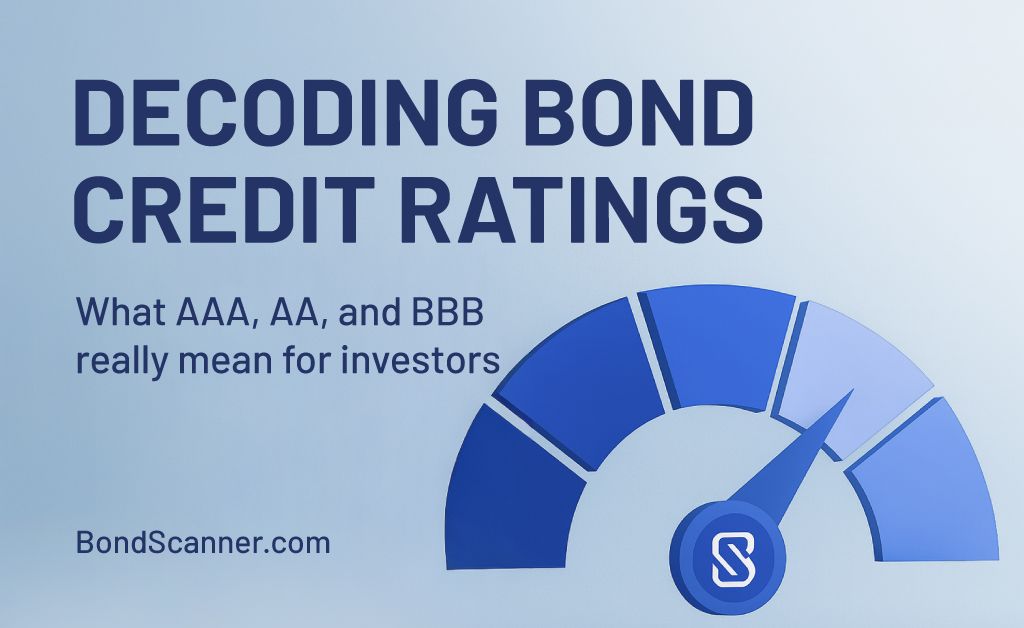Bond Credit Rating: Meaning, Importance, and Agencies in India
13 October 2025

What Is a Bond Credit Rating?
When investors consider buying a bond, one of the most crucial factors they evaluate is the bond’s credit rating. Credit ratings act as a benchmark for assessing the issuer’s ability to repay its debt on time and with interest. These ratings are issued by credit rating agencies that analyze an issuer’s financial health, repayment capacity, and overall risk profile.
This article explores the meaning of credit rating, the role of credit rating agencies in India, and how these ratings help investors make informed decisions in the fixed-income market.
A bond credit rating is an independent assessment of the creditworthiness of a bond issuer or a specific bond issue. It reflects the likelihood that the issuer will meet its financial obligations—specifically, paying interest and repaying the principal amount when due.
In simple terms, a credit rating helps investors gauge how “safe” or “risky” a bond investment might be. A higher rating (like AAA) indicates a lower default risk, while lower ratings (like BB or below) imply higher risk.
For example:
AAA-rated bonds represent the highest level of safety and reliability.
AA or A-rated bonds indicate good credit quality with low to moderate risk.
BBB and below are considered more speculative or high-yield.
These ratings are not static—they can be upgraded or downgraded based on changes in the issuer’s financial performance or market environment.
Why Are Credit Ratings Important?
Credit ratings play a critical role for both investors and issuers in the bond market.
1. For Investors:
Provide a quick understanding of the bond’s credit risk.
Help compare bonds with varying yields and maturities.
Act as a guide for building diversified portfolios with balanced risk.
2. For Issuers:
A good rating lowers borrowing costs as investors demand less interest for perceived safety.
Improves credibility in the financial market.
3. For the Market:
Ratings enhance transparency and trust by ensuring standardized assessment of credit risk.
Thus, credit ratings are a key component of efficient fixed-income investing, enabling informed decision-making and risk awareness.
How Are Credit Ratings Determined?
Credit rating agencies follow a detailed process to assign ratings. They analyze both qualitative and quantitative factors, including:
Financial Strength:
Evaluation of balance sheets, income statements, debt levels, and cash flows.
Business Profile:
Assessment of market position, industry outlook, and management quality.
Macroeconomic Factors:
Interest rates, inflation, and economic growth trends that may impact repayment capacity.
Past Performance:
Historical record of timely debt repayments and defaults, if any.
Once these parameters are analyzed, the agency assigns a rating symbol representing the issuer’s overall credit quality.
Understanding Credit Rating Symbols
| Rating Symbol | Meaning | Risk Level |
|---|---|---|
| AAA | Highest Safety | Lowest Risk |
| AA | High Safety | Very Low Risk |
| A | Adequate Safety | Low to Moderate Risk |
| BBB | Moderate Safety | Moderate Risk |
| BB | Moderate Risk | Somewhat Speculative |
| B | High Risk | Speculative |
| C/D | Default Risk | Very High Risk |
Credit Rating Agencies in India
India has several SEBI-registered credit rating agencies responsible for evaluating and publishing credit ratings of issuers and their securities. Some of the major agencies include:
01. CRISIL (Credit Rating Information Services of India Limited)
Established in 1987, CRISIL is one of the most recognized agencies in India.
Provides ratings for corporate bonds, debt instruments, and structured finance products.
02. ICRA (Investment Information and Credit Rating Agency)
Offers credit ratings, research, and risk analysis across industries.
Affiliated with Moody’s Investors Service.
03. CARE Ratings (Credit Analysis & Research Limited)
Known for its strong research framework and coverage of mid-cap and large corporate issuers.
04. India Ratings and Research (Ind-Ra)
A wholly owned subsidiary of Fitch Group.
Provides credit opinions on corporate and infrastructure debt instruments.
05. Brickwork Ratings (BWR)
Focuses on SME and municipal bond ratings in addition to corporate debt assessments.
These agencies are regulated by the Securities and Exchange Board of India (SEBI) to ensure transparency, standardization, and accountability in the credit rating process.
How Investors Use Credit Ratings
Credit ratings serve as an important reference point but should not be the sole factor in investment decisions. Investors generally use ratings to:
Filter out bonds based on acceptable risk levels (e.g., only AAA or AA-rated).
Compare yields between bonds of different ratings.
Monitor rating changes to assess potential price impacts.
For example, if a corporate bond gets downgraded from AA to BBB, its price might decline as perceived risk increases. Conversely, an upgrade may lead to a rise in bond demand.
Limitations of Credit Ratings
While credit ratings provide valuable insights, they also have limitations:
Lag Effect: Ratings may not change immediately after new financial developments.
Subjectivity: Though based on data, assessments can include qualitative judgments.
Not a Guarantee: A high rating does not completely eliminate default risk.
Hence, investors are advised to consider ratings alongside other financial indicators and their own due diligence before investing.
FAQs
1. What is the meaning of credit rating?
A credit rating reflects the creditworthiness of a bond issuer or debt instrument, indicating the likelihood of timely repayment.
2. Who assigns bond credit ratings in India?
Ratings are assigned by SEBI-registered agencies such as CRISIL, ICRA, CARE Ratings, India Ratings, and Brickwork Ratings.
3. What is the difference between AAA and BBB ratings?
AAA-rated bonds indicate the highest safety with minimal default risk, while BBB ratings denote moderate safety and higher relative risk.
4. Can a bond’s credit rating change over time?
Yes. Credit rating agencies regularly review issuers’ financial performance, and ratings can be upgraded or downgraded accordingly.
5. Should investors rely solely on credit ratings?
No. While ratings are helpful indicators, investors should conduct their own analysis or consult financial experts before investing.
Conclusion
Understanding bond credit ratings is essential for evaluating the risk and reliability of fixed-income investments. Credit rating agencies play a vital role in maintaining transparency and investor confidence by providing independent assessments.
However, investors must remember that credit ratings are indicators—not guarantees. Combining rating insights with thorough research and diversification can help achieve more balanced and informed investment outcomes.
For investors exploring India’s expanding bond market, platforms serve as a transparent and regulated gateway to credible fixed-income information.
Disclaimer
This blog is intended solely for educational and informational purposes. The bonds and securities mentioned herein are illustrative examples and should not be construed as investment advice or personal recommendations. BondScanner, as a SEBI-registered Online Bond Platform Provider (OBPP), does not provide personalized investment advice through this content.
Readers are advised to independently evaluate investment options and seek professional guidance before making financial decisions. Investments in bonds and other securities are subject to market risks, including the possible loss of principal. Please read all offer documents and risk disclosures carefully before investing.
Recent Blogs

Covered Bonds & Senior Secured Bonds Explained
An educational guide explaining covered bonds, senior secured bonds, what secured bonds mean, and how these instruments function in India’s bond market.
19 Dec 2025

Guide to Capital Gain Bonds (54EC) & Alternatives
An educational guide explaining capital gain bonds under Section 54EC, issuer options like PFC and SBI, eligibility rules, and alternatives for reinvesting sale proceeds.
19 Dec 2025

Bond ETFs in India: How They Work & When to Use Them
An educational guide explaining bond ETFs in India, their structure, returns, risks, and how products like Bharat Bond ETF and corporate bond ETFs function.
19 Dec 2025